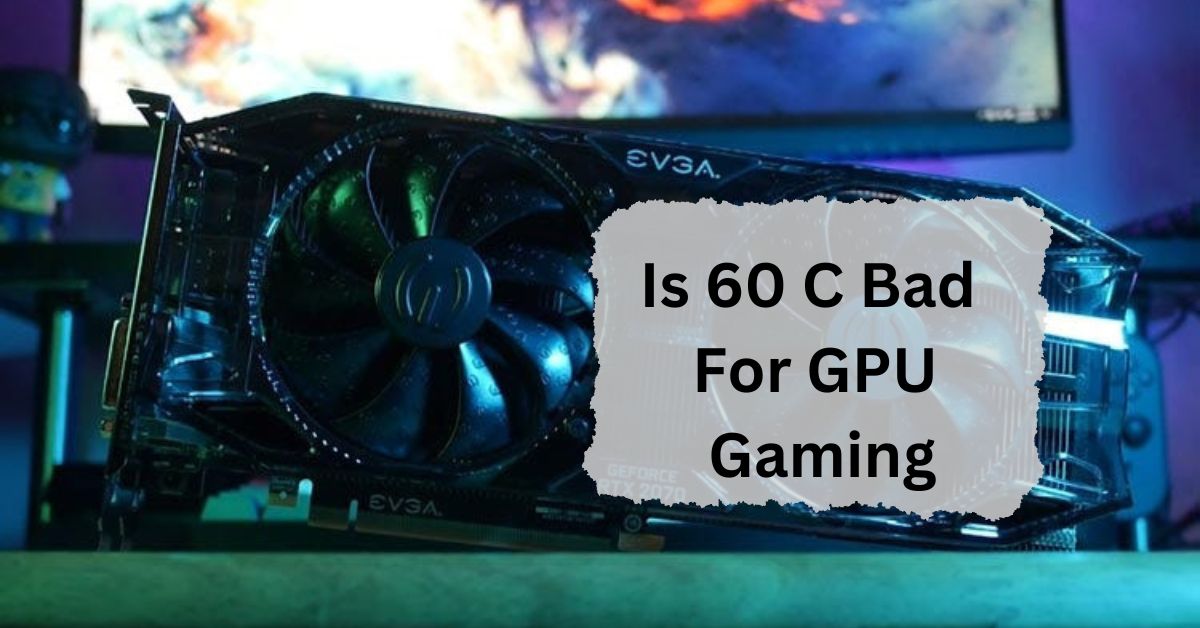Regarding gaming, GPU temperature is an important factor that can impact both the performance and the lifespan of your graphics card. Many gamers worry about the “right” temperature for their GPUs, wondering if certain levels might be harmful. One common question is: Is 60°C bad for a GPU while gaming?
No, 60°C is not bad for a GPU while gaming. It is a safe temperature range. Most GPUs can handle temperatures up to 80°C. Keeping your GPU around 60°C helps ensure it runs well and lasts longer during gaming sessions.
In this article, we’ll break down what this temperature means and whether you should be concerned.
Table of Contents
Understanding GPU Temperature Ranges:
Safe Temperature Range for GPUs:
Most modern GPUs are designed to operate safely between 60°C and 85°C during intense gaming sessions. Under normal conditions, GPUs idle around 30°C to 40°C and rise significantly when under load.
Idle vs. Gaming Temperatures for GPUs:
When you’re not gaming, your GPU’s temperature should ideally remain under 50°C. But as you start playing demanding games, it’s normal for temperatures to climb. Gaming temperatures typically fall between 60°C and 80°C.
Is 60°C Too High for Gaming?
What Happens to a GPU at 60°C:
At 60°C, your GPU is comfortably within safe limits. Most GPUs are designed to handle much higher temperatures without any risk of damage. Running at 60°C means your GPU is performing well, even under the load of a demanding game.
Comparing 60°C to Other Temperature Levels:
Compared to temperatures above 80°C, which may lead to slight throttling, 60°C is relatively low. Many high-performance GPUs can run up to 90°C before any automatic adjustments are needed, meaning 60°C is a very manageable temperature.
Factors That Affect GPU Temperature:
Hardware Specifications:
The type of GPU you have plays a role in temperature behavior. High-end GPUs with larger heatsinks and better fans generally manage temperatures better than budget or older models.
Room Temperature and Airflow:
The ambient temperature of your gaming room and the case airflow directly influence GPU temperatures. Warmer rooms or poor airflow can make your GPU run hotter.
Graphics Settings and Game Intensity:
High-resolution settings and intense game graphics put more load on the GPU, causing it to heat up. Lowering the settings can often reduce the temperature.
Why 60°C is Generally Considered Safe:
Thermal Limits of Modern GPUs:
Modern GPUs are built to withstand temperatures well above 60°C. Thermal thresholds are typically set to 85°C to 90°C or even higher, meaning that 60°C is nowhere near a dangerous level.
Common Temperature Ranges in Gaming:
Many gamers report average gaming temperatures in the 60°C to 75°C range. For most graphics cards, this is entirely normal and safe for long-term use.
How to Keep GPU Temperature Stable:
Proper Ventilation and Airflow Tips:
Good ventilation is key. Ensure that your gaming rig has adequate airflow, with clean fans and dust-free vents. Positioning your PC in an area with unrestricted airflow helps as well.
Adjusting Game Settings to Lower GPU Load:
Lowering graphics settings, such as resolution and anti-aliasing, can decrease GPU load. This helps in keeping the temperature down during extended gaming sessions.
Using Software to Monitor GPU Temperature:
Many tools, like MSI Afterburner or HWMonitor, allow you to keep an eye on your GPU’s temperature in real-time. Set alerts to notify you if the temperature goes beyond safe levels.
What Happens if GPU Temperature Exceeds Safe Levels:
Risks of Overheating:
Excessive heat can damage a GPU over time. When GPUs get too hot, they throttle down their performance to prevent damage, which can affect your gaming experience.
How GPUs Handle Overheating with Throttling:
Most GPUs are equipped with thermal throttling. This means the GPU will automatically reduce its clock speed when it gets too hot to avoid overheating, although this may slightly lower gaming performance.
Signs Your GPU Temperature Might Be Too High:
Symptoms of Overheating in Gaming:
If you notice frequent lag, crashes, or visual glitches, these could be signs of overheating. Higher temperatures can also lead to random shutdowns as a safety measure.
How to Test for Optimal Performance:
Monitoring software can help test GPU stability under different loads. Running benchmark tests or stress tests can reveal if your GPU is running smoothly or if it’s overheating.
Ways to Reduce GPU Temperature During Gaming:
Cleaning the GPU and Fans:
Dust buildup can clog fans and vents, reducing cooling efficiency. Regular cleaning of your GPU and case fans can keep temperatures in check.
Adjusting Fan Speeds in Software:
Many GPUs allow you to manually adjust fan speeds. Increasing fan speed can help bring temperatures down, especially during intensive gaming.
Cooling Solutions: Air vs. Liquid Cooling:
If you want to go further, consider upgrading your cooling system. Air coolers are effective for most users, but liquid cooling offers more efficient heat dissipation, especially for high-end GPUs.
Common Myths About GPU Temperature:
Debunking the “Lower is Always Better” Myth:
While it’s good to keep a GPU cool, it doesn’t mean that lower temperatures are always better. GPUs are designed to work within certain temperature ranges, and being slightly warm isn’t harmful.
The Truth About Temperature Spikes in GPUs:
Temperature spikes are normal, especially when starting a game or running a demanding application. Brief spikes don’t necessarily mean your GPU is in danger.
Is 60C too hot for a GPU?
No, 60°C isn’t too hot for a GPU. It’s a safe temperature, especially under load. Most GPUs can handle up to 85°C, so 60°C means effective cooling and good performance without risk of overheating.
Is 60°C while gaming good?
Yes, 60°C while gaming is a good temperature. It shows that the GPU is running efficiently and staying cool under load. Many GPUs reach 70-80°C during gaming, so 60°C reflects strong cooling and safe operation.
Is 64 degrees hot for a GPU?
No, 64°C is not hot for a GPU. It’s within the safe range for gaming and general use. Most GPUs can safely operate up to 85°C, so 64°C means your GPU is working effectively with proper cooling.
Is 60 GPU usage bad?
No, 60% GPU usage isn’t bad. It suggests the GPU is managing tasks well, especially in less demanding scenarios. High usage during intensive tasks is normal, so 60% often shows that your system is efficiently handling current workloads.
Is 60 degrees Celsius Hot For A GPU?
No, 60°C isn’t hot for a GPU. It’s within a comfortable operating range. Many GPUs are built to handle temperatures up to 85°C, so 60°C is safe and reflects effective cooling, especially during gaming or heavy processing.
Is 60 degrees Celsius really hot for your GPU?
No, 60°C is not really hot for a GPU. It’s actually quite normal during usage. High temperatures for GPUs typically start above 80°C, so 60°C indicates safe and efficient cooling without stressing the hardware.
What temperature should my GPU have when playing a game?
For gaming, a GPU should ideally be between 60-80°C. This range is considered safe for most GPUs, and temperatures below 80°C generally indicate that the system’s cooling is handling the load well.
Is 60+ C scary bad for my GPU?
No, 60+°C isn’t scary or bad for a GPU. GPUs are designed to safely run at temperatures up to 85°C. Anything around 60°C means efficient cooling and safe usage, even during gaming or heavy tasks.
GPU max at 60 degrees Celsius?
A GPU maxing at 60°C is excellent. It shows that your system’s cooling is effective, keeping the GPU well below its maximum limit. Most GPUs can reach up to 85°C without issues, so 60°C is very safe.
Why is my GPU hot (60 C at idle)?
A GPU at 60°C while idle could be due to limited airflow, dust buildup, or high room temperature. Cleaning dust, improving airflow, or reapplying thermal paste can help lower idle temperatures if needed.
What is considered a “good” GPU temperature?
A good GPU temperature under load is between 60-80°C, with anything below 60°C being excellent. For idle, 30-50°C is ideal. This range ensures efficient performance and helps maintain a longer GPU lifespan.
What is a safe GPU temperature?
A safe GPU temperature under load is typically 80°C or lower. Some GPUs handle slightly higher temperatures, but staying below 85°C is ideal. These temperatures ensure reliable performance and help prevent long-term damage.
Is 60 degrees Celsius hot for a GPU idle?
Yes, 60°C is high for an idle GPU. Idle temperatures are generally around 30-50°C. A high idle temperature may suggest poor airflow, dust, or cooling issues. Cleaning or checking airflow can help lower idle temperature.
Is 60 degrees Celsius hot for a GPU laptop?
No, 60°C isn’t hot for a laptop GPU. Laptops naturally run warmer due to less airflow. For most laptops, 60°C is a safe temperature even under load, as they’re built to handle slightly higher temperatures.
Is 60 degrees Celsius hot for a GPU Nvidia?
No, 60°C is not hot for an Nvidia GPU. It’s within a safe operating range. Nvidia GPUs generally manage well up to 85°C, so 60°C reflects good cooling and efficient performance without overheating risks.
Is 70 degrees hot for a GPU while gaming?
No, 70°C isn’t hot for a GPU during gaming. It’s within the normal range for many GPUs under load. Most GPUs can operate safely up to 85°C, so 70°C indicates the GPU is handling tasks well.
Is 60°C bad for CPU?
No, 60°C isn’t bad for a CPU. It’s a safe temperature, especially during heavy tasks. Most CPUs are designed to handle temperatures up to 90-100°C, so 60°C is well within safe limits and shows effective cooling.
Is 64 degrees Celsius hot for a CPU?
No, 64°C isn’t hot for a CPU. It’s within a safe range for typical usage. CPUs can tolerate temperatures up to 90-100°C, so 64°C reflects effective cooling and indicates that your CPU is operating comfortably.
FAQs:
Is 60°C Bad for GPU in the Long Run?
No, 60°C is safe for long-term GPU use. Most GPUs can handle temperatures up to 80°C or higher without harm.
What’s a Dangerous Temperature for GPUs?
Generally, above 90°C is considered dangerous. However, most GPUs have built-in mechanisms to prevent damage at these levels.
Does GPU Temperature Affect Gaming Performance?
Yes, extreme temperatures can lead to throttling, which reduces performance. However, 60°C is well below such levels.
How Often Should I Monitor My GPU Temperature?
Checking your GPU temperature occasionally, especially during gaming, is sufficient. Monitoring software can help track any unusual spikes.
Should I Invest in Additional Cooling for My GPU?
If you’re consistently seeing high temperatures (80°C+), additional cooling may help. Otherwise, standard cooling setups are adequate for most gaming needs.
Conclusion:
In conclusion, a GPU temperature of 60°C is safe and effective for gaming. It keeps your GPU running well and helps it last longer. Most GPUs can handle much higher temperatures, so staying around 60°C means your system’s cooling works well. Regular monitoring and proper airflow can help maintain safe temperatures.

I’m Noah Lucas, the voice behind the content you find here. With 5 years of experience in the GPU field, my goal is to provide clear and helpful information to everyone interested in this technology.
Whether you’re new to GPUs or looking to deepen your understanding, my articles aim to break down complex topics into simple, easy-to-understand language. This way, no matter where you’re from, you can find the information you need without any confusion.

